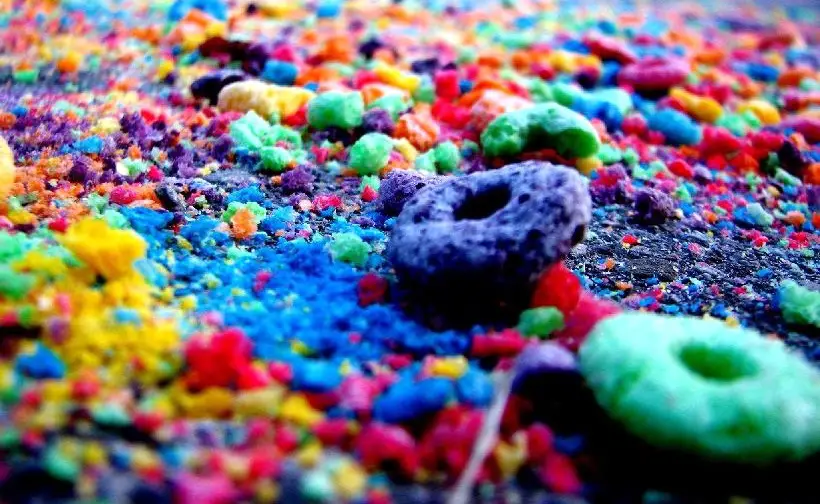Contributing Writer for Wake Up World
Natural and alternative health advocates have long known that artificial (synthetic) food additives have had a negative effect on human health.
Currently, although links have been made between consumption of food additives and increased hyperactivity (as well as cancer, chromosomal damage and other adverse affects), the FDA continues to drag its feet by still maintaining its stance that the results of such findings are “inconclusive” and continuing to recommend the use of ADHD drugs, while allowing the use of these dangerous additives.
Common Food Dyes & Additives
The use of unnatural substances to give food the appearance of something natural is a strange concept indeed. In the USA, there are seven artificial colorings that are permitted by the FDA. They are:
• FD&C Blue No. 1 – Brilliant Blue FCF, E133 (blue shade)
• FD&C Blue No. 2 – Indigotine, E132 (indigo shade)
• FD&C Green No. 3 – Fast Green FCF, E143 (turquoise shade)
• FD&C Red No. 40 – Allura Red AC, E129 (red shade)
• FD&C Red No. 3 – Erythrosine, E127 (pink shade, commonly used in glacé cherries)
• FD&C Yellow No. 5 – Tartrazine, E102 (yellow shade)
• FD&C Yellow No. 6 – Sunset Yellow FCF, E110 (orange shade)
In recent years, others such as FD&C Red No. 2, FD&C Red No. 4, and FD&C Red No. 32”Ž (to name a few) were banned for use due to ill effects on human health.
The FDA is Confused
However, the Food and Drug Administration is confused, and a bit confusing. In 2006 it released a statement that “FDA officials recommend stronger warnings for ADHD drugs”. Kate Gelperin, a drug-safety expert at the FDA, told members of the agency’s Pediatric Advisory Committee in a daylong meeting; “We recommend that these issues be addressed”. She said regulators were struck by a surprising number of cases of “hallucinations, both visual and tactile, involving insects, snakes and worms”, characterizing the tales as “particularly traumatic and undesirable”.
Another report compiled from FDA data also showed that the FDA was unable to identify risk factors in patients that physicians should look out for before prescribing the drugs. “No risk factors were identified which could account for the majority of reports of psychosis-related events… Also of note, in the overwhelming majority of cases, the patient had no prior history of a similar condition.”
Susanna N. Visser, who oversees the Center for Disease Control (CDC) research on ADHD, expressed her concerns in 2009, stating that “families of toddlers with behavioral problems are coming to the doctor’s office for help, and the help they’re getting too often is a prescription for a Class II controlled substance, which has not been established as safe for that young of a child. It puts these children and their developing minds at risk, and their health is at risk.”
ADHD & Cancer Linked to Food Dyes
Interestingly, five of the allowed colors in the USA were linked to ADHD, cancer and other health conditions in Europe in a study conducted by Southampton University, which found these dyes to cause elementary school aged children to become distracted, failing computer attention tests.
According to a recent CBS News report, the Center for Science in the Public Interest (CSPI) says that dyes used in a many commercial food products (from breakfast cereals and salad dressings) present a “rainbow of risks”, including hyperactivity, allergies and cancer. Michael F. Jacobson, executive director of CSPI wrote “These synthetic chemicals do absolutely nothing to improve the nutritional quality or safety of foods, but trigger behavior problems in children and, possibly, cancer in anybody… The Food and Drug Administration should ban dyes, which would force industry to color foods with real food ingredients, not toxic petrochemicals.”
Food Dyes and Known Risks
In the USA, the five commonly used synthetic dyes are:
Tartrazine
(also known as E number E102, C.I. 19140, or FD&C Yellow 5)
This dye is commonly found in confectionery, cotton candy, soft drinks (Mountain Dew), energy drinks, instant puddings, flavored corn chips (Doritos, Nachos, etc), cereals (corn flakes, muesli, etc.), cake mixes, pastries, custard powder, yellow popcorn, soups (particularly instant or “cube” soups), sauces, some rices (like paella, risotto, etc.), powdered drink mixes, sports drinks, ice cream, ice pops, candy, Peeps marshmallow treats, chewing gum, marzipan, jam, jelly, gelatins, marmalade, mustard, horseradish, yogurt, noodles such as Kraft Dinner, pickles and other pickled products, certain brands of fruit squash, fruit cordial, potato chips, Biscuits, and many convenience foods together with glycerin, lemon and honey products.
Known health effects: causes hyperactivity, chromosomal damage, and has been linked to allergic reactions and migraine headaches.
Sunset Yellow
(also known as Orange Yellow S, FD&C Yellow 6 or C.I. 15985)
Sunset Yellow is often found in orange sodas, orange jelly, marzipan, Swiss rolls, apricot jam, citrus marmalade, lemon curd, sweets, hot chocolate mix and packet soups, trifle mix, breadcrumbs, snack chips, shelf fresh noodles, cheese sauce mixes as well as chocolates such as Cadbury Creme Egg.
Known health effects: causes hyperactivity, cancer and is linked to stomach upsets and swelling of the skin.
Allura red
(also known as Food Red 17, C.I. 16035, FD&C Red 40, E129)
Can be found in soft drinks, candy, children’s medications, cereal, beverages, snacks, gelatin desserts, baked goods, ice cream.
Known health effects: causes hyperactivity, cancer and may bring on allergic reactions.
Indigotine
(also known as FD&C Blue No. 2 , E132 (indigo shade)
Can be found in soft drinks, bakery products, cereals, candy, drink powders, mint-flavored jelly, frozen desserts, pet foods, kidney tests and for testing milk.
Known health effects: causes hyperactivity, asthma, heart issues and may bring on allergic reactions.
Brilliant Blue
(also known as FD&C Blue No. 1, FCF, E133 (blue shade)
Can be found in soft drinks, gelatin desserts, ice cream, drink powders, candy, bakery products, cereals, feta cheese, dairy products and pudding. Also used in toothpaste, mouthwash, deodorants, cosmetics and pet foods.
Known health effects: causes low blood pressure, asthma, hives, and may bring on allergic reactions.
Caution: Do not consume if sensitive to aspirin.
In 2003 the FDA also sent out a safety warning concerning the use of Blue no. 1 as a detection method in medical procedures:
“There were several reports of toxicity, including death, temporally associated with the use of FD & C Blue No. 1 (Blue 1) in enteral feeding solutions. The dye was used to help detection and/or monitoring of pulmonary aspiration in patients being fed by an enteral feeding tube. Reported episodes were manifested by blue discolouration of the skin, urine, faeces or serum and were associated with serious complications such as refractory hypotension, metabolic acidosis and death. Seriously ill patients, particularly those with a likely increase in gut permeability, may be at greater risk.”
Why Do We Need Food Dyes Anyway?
And what exactly is the need of these food dyes in our food? Absolutely none – other than to add a specific “desirable” color (often to attract children).
So, with estimated users of ADHD drugs in the multi-millions in both children and adults, shouldn’t the question be…what is causing this behavior rather than routinely administering dangerous (but profitable) pharmaceutical drugs?
Isn’t it logical that an artificial substance such as food coloring along with preservatives, processing, and ridiculously high amounts of sugar (not to mention high corn fructose in practically every product sold) could possibly have a negative effect on our health?
Thank-goodness research is now linking what some of you have known all along: That unprocessed natural and organic whole foods, free of preservatives additives and chemicals, are the only foods we should be eating in order to be healthy and to live a long energetic life!
No research is required… only common sense.
Resources:
- Artificial Colors In Food: Is FDA Certification Enough?
- Food Colouring: The Good, The Bad & The Ugly!
- Food coloring: Purpose of food coloring
- FDA and Food Dyes
- Banned in Europe, Food Coloring Linked to Behavior Problems
- Food Dyes Suspected Of Causing Behavioral Problems In Kids
- Kraft under pressure over ‘cancer-causing’ yellow food coloring in Macaroni & Cheese after 41,000 sign petition to ban additive
- ADHD Drugs Linked to Sudden Death in Kids
- Soothe ADD/ADHD Symptoms Naturally with These Tips
- Antipsychotics for ADHD? There is Something Wrong with Our Medical Establishment
- 12 Shocking Facts About the Dangers of Psychiatric Drugs
Previous articles by Dr. Michelle:
- The Dangers of Warfarin (Coumadin) – Natural Alternatives for Stroke Prevention
- Macadamia Oil for Healthy Skin and Body
- Studies Prove Sweet Potatoes Heal Stomach Ulcers
- The Truth About Insomnia, Depression and Anxiety
- Are There Natural Cures for ALS?
- The Arrogance of Modern Medicine
- Natural Cure for Depression Silenced?
- The Link Between Stress and Intestinal Parasites – and What to Do About Them
- Arthritis Cure Found in Nature
- The Sun & Skin Cancer: Examining the Truths, Pseudo-Truths & Lies of Mainstream Science
- “Blame It On Your Genes”: the Money-Making Myth of Modern Medicine
- A Natural Cure for Migraines
- Natural Cure for Chronic Pain Syndromes Silenced by the Medical Establishment
About the author:
Dr. Michelle Kmiec is a board certified chiropractic physician who also holds a Bachelor of Science degree in Human Biology, and a minor in Medical Research. She is a life-long athlete who after curing herself 100% naturally from MS and anxiety, became an avid nutrition health researcher/promoter. She has been featured in many Health magazines, and has been a guest on radio talk shows in the USA, Canada, United Kingdom, and Australia. She is the author of Health Freedom Revolution: Exposing the Lies, Deceit and Greed of the Medical Profession’, Founder of Online Holistic Health, and a contributing writer for other popular informative health website/blogs. She is also founder of The Triad of Life™ Holistic Lifestyle Program – the most comprehensive holistic program on the internet today.
For more information, visit Online Holistic Health or connect with Dr. Michelle Kmiec on Facebook, Twitter and LinkedIn.

If you've ever found value in our articles, we'd greatly appreciate your support by purchasing Mindful Meditation Techniques for Kids - A Practical Guide for Adults to Empower Kids with the Gift of Inner Peace and Resilience for Life.
In the spirit of mindfulness, we encourage you to choose the paperback version. Delve into its pages away from screen glare and notifications, allowing yourself to fully immerse in the transformative practices within. The physical book enriches the learning process and serves as a tangible commitment to mindfulness, easily shared among family and friends.
Over the past few years, Wake Up World has faced significant online censorship, impacting our financial ability to stay online. Instead of soliciting donations, we're exploring win-win solutions with our readers to remain financially viable. Moving into book publishing, we hope to secure ongoing funds to continue our mission. With over 8,500 articles published in the past 13 years, we are committed to keeping our content free and accessible to everyone, without resorting to a paywall.








